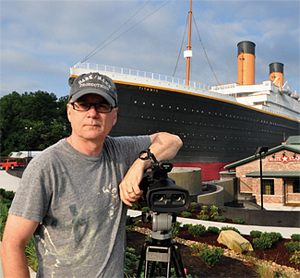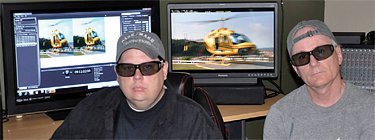3D for the Rest of Us

When I first saw CineForm's Neo3D software demonstrated at the 2009 NAB Show, I hoped it would fulfill the promise of 3D "for the rest of us." Sure it's great to have the budget of "Avatar," but if stereoscopic 3D is ever going to become a mainstream medium it will have to get out of the studio financial system and into the hands of adventurous independents. With Neo3D, that is finally possible.
CineForm's Neo3D not only gives most mainstream NLE's true editing capabilities on either Windows or Mac platforms, but since it also gives you the kind of convergence control between the left/right eyes, it is also a powerful mastering tool.
TENNESSEE TEST
Now HD pioneer Randall Dark has put the system to a real world test on the "3 Cities in 3D" documentary he produced and directed for WealthTV to be aired as part of its WOW! series in late summer. It's an affectionate travelogue cruising through the Great Smoky Mountains region around Sevierville, Pigeon Forge, and Gatlinburg, Tenn., (see "A 3D Ode to the Smokies").
Dark has been a video pioneer ever since he opened the first HD studio in New York back when "high definition" was analog (remember the 1,125 line Hi-Vision system?) and he has kept riding the cutting edge ever since.
That's one reason Dark was able to get his hands on a Panavision AG-3DA1 single-body 3D camera to shoot the "3 Cities in 3D" project long before the camera's official release date of August 27. He affectionately calls the cute little unit "Wall-E" in honor of its face plate.
To post the "3 Cities in 3D" doc, Dark paired with Shane Marr, the head of Cinemarr Entertainment, in Sevierville, Tenn., and Marr immediately saw the advantage of invoking CineForm's Neo3D for his post process.

Randall Dark at the Titanic Museum in Pigeon Forge, Tenn. "It simply levels the playing field," Randall beamed. "The combination of the Panasonic AG-3DA1 camera and CineForm's Neo3D software lets independent producers tell our stories in 3D within an affordable budget."
Neo3D works with Apple Final Cut Pro, Avid Media Composer v.5.0, and Sony Creative Software's Vegas Pro 9.1. But Marr chose to put it on his Adobe Premiere CS5 editing system on a custom-designed Windows workstation powered by an Intel Core i7 processor. In fact, the whole system was specifically designed with the needs of 3D editing with Neo3D in mind. The process begins by using a CineForm codec to create a file that contains full resolution left and right eye information in a single AVI or MOV wrapper.
"The great thing is we didn't have to sync anything," Marr began. "As soon as we imported the HD video out of the Panasonic camera, the two eyes are muxed together and I can start editing either the left or right eye as I wish using normal Premier Pro CS5 protocols just like I was editing a regular 2D show."
Not everyone has the luxury of a Randall Dark production to get access to several kinds of 3D display technologies to evaluate the way the edited images look in Z-space, but Marr quickly learned that it was very important to be able to judge his edits in 3D as the project progressed.
Marr interfaced with Neo3D's image adjustment capabilities through CineForm's First Light application that lets him make 3D image adjustments like non-destructive primary color correction and even 2D/3D text and graphics overlays as Active Metadata layers on top of the underlying 3D video layer.
But Neo3D's most impressive feature, and frankly the one that stopped me in my tracks at the NAB Show, is the ability to view a combined 3D image in anaglyph on a standard 2D editing monitor.
"I use a red/cyan display on my computer screen to let me evaluate where the convergence point is and adjust it if needed using simple anaglyph glasses," Marr said. "Of course, we considered the 3D depth carefully when screening dailies, but adjusting it later is the kind of capability that would require massive processing in other systems."
3D SHOT SELECTION
Even though basic storytelling is Shane's main purpose and he did not want the 3D to get gimmicky, like many editors, he has learned that the added dimension affects his pacing and shot selection.
"You have to take into account that what seems slow in 2D may be just what the eye wants to see in 3D," Marr explained, "There are times when your instinct tells you to cut faster in flat space but you have to slow it down in this new dimension.

Shane Marr, head of Cinemarr Entertainment, and Randall Dark of Randall Dark Productions For example, we have a shot where a man is sliding down a zip line toward the camera. If this were a fast music video in 2D I'd chop it into many individual shots. But in 3D, we locked off the camera and let the man come up to the lens and fly out of frame. It worked really cool."
Even after reviewing a cut sequence, Neo3D lets you go back and adjust the convergence of a shot. "I just go back into the CS5 software and pull up a timeline," Marr said, "and use First Light to manually tweak the 3D look. Then it automatically updates the file for future use."
Like Dark, Marr has become a 3D devotee. As he puts it, "It's like trying to explain what a color TV is where there is only black and white. Once you see it, it's like, man! How did I live without it?"
CineForm has been working with Panasonic for some time to help the post production process using the AG-3DA1's computationally-intensive AVCHD (Advanced Video Codec High Definition) file format.
"They've been giving us early files from the AG-3DA1 camera because they wanted a viable editing workflow to be available when the camera is released," said CEO David Taylor for Cineform in Solana Beach, Calif. "Although Neo3D is our flagship product, many of its features are also available in the less expensive NeoHD software, including convergence adjustment by keyframing different user-defined points. You can even do what we call a 'convergence dissolve' to smooth the transition of convergence points between edits. Our goal is to make 3D post available for all levels of production."
Jay Ankeney is a freelance editor and post-production consultant based in Los Angeles. Write him at 220 39th St. (upper), Manhattan Beach, Calif. 90266 or atJayAnkeney@mac.com.
Get the TV Tech Newsletter
The professional video industry's #1 source for news, trends and product and tech information. Sign up below.
